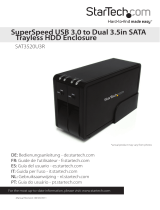
Instruction Manual
i
Table of Contents
Product Diagram ....................................................................................1
Front View .................................................................................................................................................... 1
Rear View ...................................................................................................................................................... 1
Introduction ............................................................................................ 2
Packaging Contents ................................................................................................................................. 2
Recommended System Requirements ..............................................................................................2
Getting Started .......................................................................................2
Step 1. Installing your hard drives .......................................................................................................2
Step 2. Set your RAID Conguration .................................................................................................. 7
Step 3. NAS Setup ..................................................................................................................................... 8
Step 4. Initialize Your Hard Drives ........................................................................................................ 9
Step 5. Use your NAS ................................................................................................................................ 11
Basic NAS Operation ................................................................................................................................ 11
Advanced NAS Operation ...................................................................................................................... 24
View Firmware Version ..........................................................................27
View Internal IP .......................................................................................................................................... 28
View MAC Address .................................................................................................................................... 28
View PPPoE IP Address or Connect to PPPoE Internet Service ................................................. 29
Enable or disable Service Information .............................................................................................. 29
View or Change IP Setting ..................................................................................................................... 32
Manage your Hard Drive Conguration, .......................................................................................... 40
Manage your RAID Conguration .......................................................43
Update your NAS Enclosure Firmware Update...............................................................................46
Reboot Your NAS Enclosure remotely using the Web Interface ............................................... 48
Shutdown your NAS Enclosure remotely using the Web Interface ........................................49




























